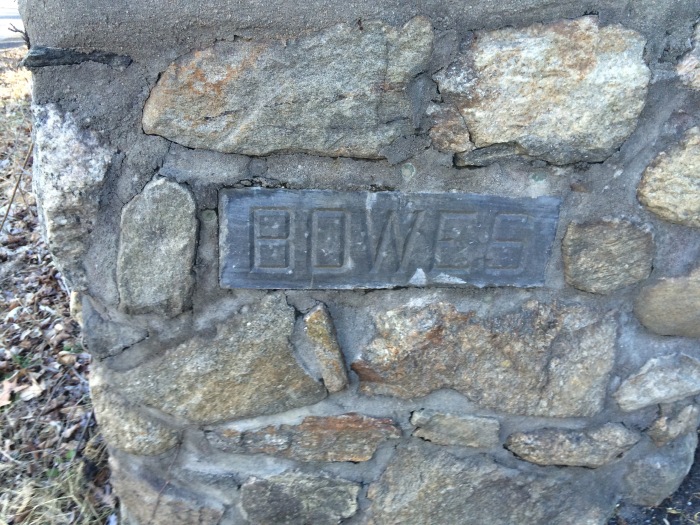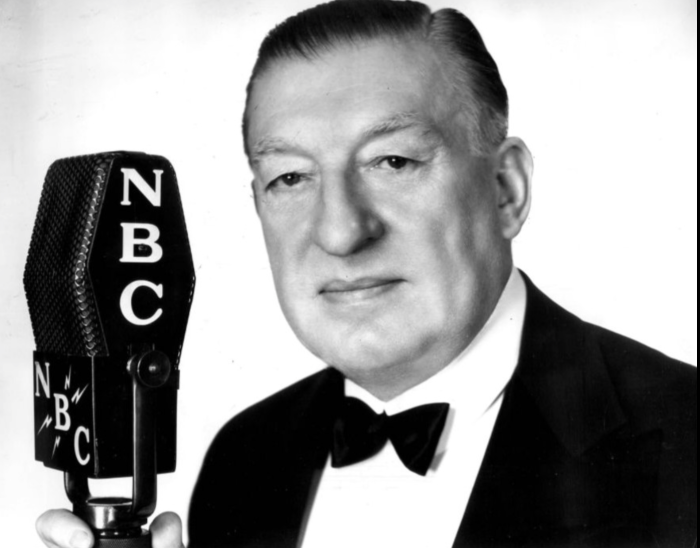Have you ever noticed how many plaques you can find in stone gateways in this area? I’ve see these ones all within about three miles of each other:
At the corner of Allapartus and Spring Valley Roads.

On Spring Valley Road

On Cedar Lane
Well, settle in, because I’m going to tell you the story of BOWES. (I’ll save the other two for later posts.)
My regular-I-just-need-to-get-out-and-run run goes right past this particular plaque. What does “Bowes” mean, I wonder each time I pass it. Then I just keep running and forget about it until next time.
Now, thanks to writing this blog, I’ve finally taken the time to research it and discovered that it’s the ghost of the Ossining estate called “Laurel Hill” once owned by Major Edward Bowes.
Bowes was best-known as a radio star who hosted an American Idol/Gong Show-type of talent show called “The Major Bowes Amateur Hour” in the 1930s and 1940s (You can buy CDs of it here.)

His Sunday night show was tremendously popular – according to a December 1, 1935 article in the New York Times, its popularity was “reported to be the highest ever attained since telephone surveys in 40 key cities was first tabulated.”
The format is something we’re very familiar with now, but at the time it was ground-breaking — amateurs came from all over the country to audition and the lucky few appeared on Major Bowes’ show. The gimmick of the show was in its audience participation — the performances on the show were voted on via telephone for each episode. Many of the winners then went on to tour the dying vaudeville circuit in “Major Bowes’ Amateur Hours” units for a pittance and thence into obscurity.
The show began in 1934 and ran until the early 1940s, when wartime restrictions on telephone usage cut into Bowes’ reliance on the audience vote. Soon after, the show went off the air.
His New York Times obituary noted that:
“The possibility of success attracted ambitious amateurs from all over the country, from one-man bands to singers, from tap dancers to harmonica viruosi.” The pilgrimage soon became too popular, and in 1935 the Emergency Relief Bureau put up the storm signals disclosing that each week more than 300 penniless would-be radio amateurs were stranded in this city. Major Bowes stemmed the cityward trek by establishing quarter-annual auditions in the hinterlands, winners of which were brought to New York.”
A few contestants did go on to fame and fortune, like opera singers Beverly Sills & Lily Pons. Others on that short list include Robert Merrill, Redd Foxx & Glady Knight. Frank Sinatra made an appearance in September of 1935, singing with a group called the Hoboken Four. They received over 40,000 phone calls, the most of any act in the history of the show up until then. (They then went on to make a couple of short films for Major Bowes, one called “The Big Minstrel Act” in which they all wore blackface. Things were different back then . . .)
By 1937, according to a US Treasury Department report to Congress detailing the salaries of the 15,000 wealthiest Americans, Major Bowes was making $427,817 from his radio show and its spin-offs. (The man with the highest salary was movie producer Louis B. Mayer, with $1,161,753. But our very own Major Edward Bowes was sixth on the list – behind the likes of Frederic March and Greta Garbo, among others.) Just FYI, Bowes’ salary equals about $7.2 million in 2016 dollars.
But radio wasn’t his first, or even second, successful career. No, Bowes got his start in San Francisco real estate, apparently amassing quite a personal fortune which was decimated by the 1906 earthquake. But he bounced back quickly, finding opportunity in the rubble, and then moved to New York where he ventured into theatrical real estate and producing. By the 1920s, he was managing director of the Capitol Theater, one of the first movie palaces in New York City.
It was then that he started insisting on be addressed as “Major” Bowes, a rank he apparently attained in the US Army Reserves.
“The Original Amateur Hour” grew out of his interest in the Capitol Theater. In the early days of radio, as a promotion feature for the theatre, Bowes started a Sunday noon hour broadcast over local radio station WHN. By 1934, the idea of the Amateur Hour had evolved and the program was presented nationally as “The Major Bowes Amateur Hour.”
In the middle of the Depression, Major Bowes did very well for himself. In addition to his princely salary, I found stories on the Internet about his 61-ton yacht called the Edmar, which he donated to the US Navy in 1940. Then there was the story of his “specially built car with a dining space for six persons” that had been burgled in its garage on West 53rd Street in 1941, and various gold rimmed glassware, gold cutlery and gold corkscrews were stolen, in addition to a fox fur automobile robe. My, my! An art connoisseur, his collection was sold at auction after his death, to the tune of $121,399, not to mention the Andrea del Sartos and El Grecos he had previously donated to the Catholic Church. A former real estate man, he also amassed quite a real estate portfolio, the details of which didn’t really interest me enough to Google, but you should feel free to.
Major Bowes married the actress (and Daniel Frohman’s ex-wife) Margaret Illington in 1910 (more on her in a future post.) At some point, they purchased Laurel Hill and it became famous for its 14,000 laurel bushes and large, old trees. At its height, it boasted a main house of ten rooms, several guest houses and a swimming pool. Sadly, the main house was destroyed by fire in 1937. I suppose Bowes did some rebuilding, because in 1940, he donated his estate to the Lutheran Church for use as a retreat and it is still in use today. (See link.)
Bowes died at the age of 72, and it was reported that his last rites were performed by none other than Francis Cardinal Spellman. Widowed in 1934, he had no children, and left most of his money to the Catholic Church.
3 thoughts on “Major Bowes, 1930s Radio King”